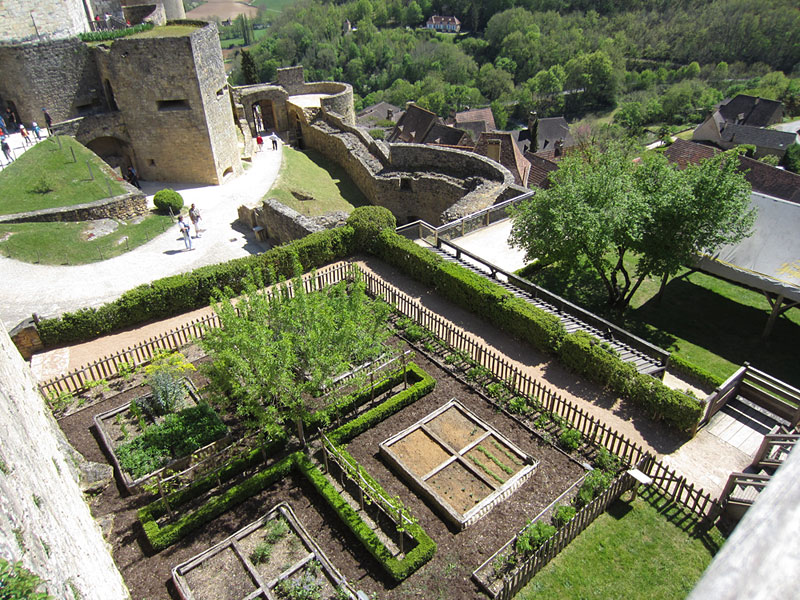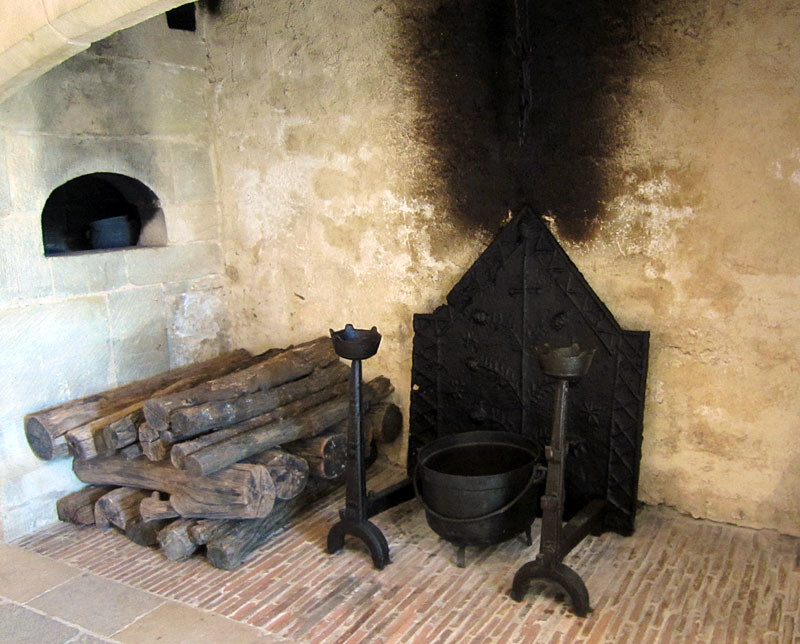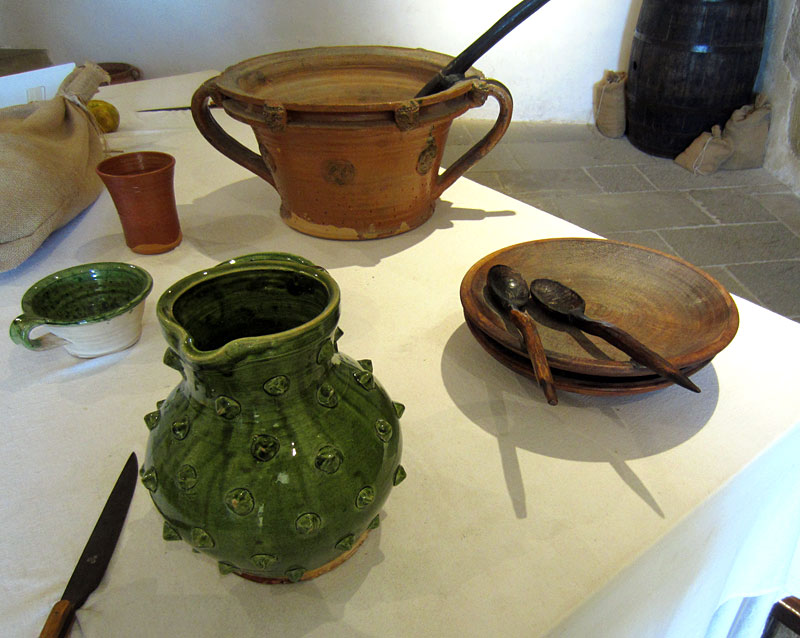The medieval kitchen is a source of fascination for many people, especially if they love history and medieval recipes. Whenever I visit a medieval castle or donjon, if there’s a kitchen still relatively intact I can’t wait to see it! By comparison to a medieval banquet hall with its usual, impressive architecture and fireplace, a medieval kitchen might not seem as colourful and exciting. However, it’s importance and usefulness in medieval life cannot be underestimated. Let’s take a closer look.
The Medieval Kitchen – What Was Its Purpose?
 The medieval kitchen was at the heart of any castle or fortress. Its daily mission? To prepare and serve food in the best possible way, with the best possible ingredients for the lord of the castle, their family and guests. Entertaining was high on the agenda for most castle owners and the more splendid the meal, the greater their reputation. So, when it came to a special celebration, a medieval banquet menu was often the order of the day.
The medieval kitchen was at the heart of any castle or fortress. Its daily mission? To prepare and serve food in the best possible way, with the best possible ingredients for the lord of the castle, their family and guests. Entertaining was high on the agenda for most castle owners and the more splendid the meal, the greater their reputation. So, when it came to a special celebration, a medieval banquet menu was often the order of the day.
In this scenario, the castle kitchen transformed itself into the most incredible hive of activity – well in advance of the banquet itself! Organisation and preparation was paramount if the banquet was to be a success. Accordingly, every aspect of the banquet menu had to be carefully planned so that orders were put in at exactly the right time for all the necessary ingredients.
These ingredients usually included:
- Fresh meat including red meat, game and poultry
- Fresh fish, usually freshwater fish from a nearby river
- Fresh fruit and herbs often from the castle’s medieval garden
- Fresh grain for baking bread
Sourcing Ingredients For The Kitchen
Almost all ingredients in medieval cooking had a local source, invariably supplied fresh on the day. Many castles and fortresses had their own medieval garden, so the range of ingredients available to the kitchen was even greater.

Medieval castle garden
A medieval garden was a source of many recipe ingredients – fresh fruit such as quince, apples and blackberries used in dessert recipes and jams) and fresh vegetables and herbs used in meat, fish and poultry dishes. This medieval fish recipe is a good example as it requires fresh parsley and mint. If you read my A-Z list of medieval herbs you will get some idea of the amazing variety that was grown.
Read more about the variety of fruit and vegetables that could have found their way from a medieval garden into a castle kitchen.
What Did A Medieval Castle Kitchen Look Like?
All medieval castles, from the grandest to the smallest, had a kitchen. A fireplace, plenty of firewood, roasting spit, casks of grain and wide array of kitchen bowls, jugs and utensils were key features.
Medieval Kitchen Fireplace
Below is the massive fireplace in the kitchen of the grand French medieval castle at Castelnaud La Chappelle the Dordogne. The castle dates from the 12th or 13th century (it was first mentioned in 13th century documents), so the solid stone fireplace is around 800 years old – truly medieval.
Having taking this photograph myself, I can honestly say that it does not fully convey the size of the fireplace. It is actually big enough to stand up in and walk around. The logs stacked in the corner of the hearth reflect this, as they are more like tree trunks! It was important for medieval castle cooks to be able to roast anything, of any size or volume in their kitchen. So, a reliable, long-burning fire was needed with plenty of firewood available. The meat or game waiting to be roasted was usually hung above the fireplace in readiness (the animals in the photo above are of course replicas).
Spit Roasting
Spit-roasting was the traditional way of cooking meat and game and this was done in both small and large medieval kitchens.

If a medieval banquet was being catered for, spit-roasting a boar was often a key task for the kitchen staff. Roasting such meat required a large hearth and chimney as did the roasting of chickens and small game if several needed to be spit roasted at the same time.
The medieval roasting spit was operated manually by one or more of the castle servants (boys or an apprentice cooks). They would spend hours turning the spit handle, basting the meat and checking how it was cooking. Being a ‘spit boy’, as they were known, was not an easy or pleasant job but such were the times that more menial tasks were done this way.
Medieval Bread Oven
A medieval kitchen was not complete without at least one bread oven. Some castles had multiple bread ovens in order to produce a larger volume of bread to cater for the household of both guests and servants. The first 30 seconds of this video of clip show the medieval bread ovens in the Dogs Tower of Chinon Castle in France. Note: The rest of the video is well worth watching for anyone who likes medieval history because it moves on to Fontevraud Abbey and the tombs of Eleanor Of Aquitaine, Henry II of England and their son Richard The Lionheart.
This next photo which I took shows a bread oven built into one of the walls of the kitchen fireplace at Castelnaud-La-Chapelle. Notice the heat and smoke-streaked wall above it. Bread baking was done every day in such a kitchen. Learn more about medieval bread and how white bread was regarded as superior to brown bread – the opposite of what a 21st century nutrionist might say!
Medieval Kitchen Utensils
Medieval cooks needed the same basic utensils in their kitchen as we do today, from mixing bowls to dishes and spoons, cups and jugs. In that respect, little has changed to the modern day. The only kitchen utensils we use today that are very different from those in a medieval kitchen are powered ones such as an electric blender. A pestle and mortar just takes a little longer!
From baking medieval bread and making pottage for the kitchen staff to preparing a creamy almond milk recipe for the castle lord, the utensils were just the same. Measuring, mixing, pouring and stirring – that’s what cooking is all about, whether medieval or modern and irrespective of rank!
Medieval Kitchen Video
Below is a short video clip I filmed many years ago of a much smaller kitchen, again in France but this time at the medieval castle of St. Mesmin in the Vendée.
The original castle at St. Mesmin was 13th century and visitors to the site today can see many examples of what it was like to live in a fortress from that era. There is a simple essence to this style of small castle kitchen and it offers a wonderful insight into what essential, basic cooking must have been like for medieval people.
Medieval Cauldron Cooking
When you watch the video (above) look out for the cauldron which stands in the fireplace. It may not look much, but a cauldron was one of the most important items in a medieval kitchen and, what’s more, it was used for cooking all kinds of recipes. Two of the most common recipes that would have graced a medieval cauldron were recipes for making vegetable pottage and a meat stew.
 I developed my own cabbage pottage and medieval stew recipes and since I first published them many years ago, they have become amongst the most popular on this website. To me this proves two things – that people’s basic tastes have not really changed over the centures and that it doesn’t mater whether you have a cauldron or not!
I developed my own cabbage pottage and medieval stew recipes and since I first published them many years ago, they have become amongst the most popular on this website. To me this proves two things – that people’s basic tastes have not really changed over the centures and that it doesn’t mater whether you have a cauldron or not!
For more medieval recipes please click on the Recipes Grid. From bread to fish and chicken dishes, medieval mushy peas and my favourite medieval sweet treat: medieval gingerbread!








